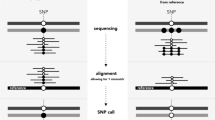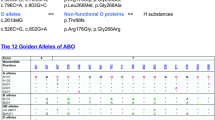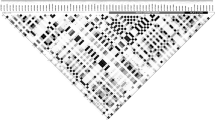Abstract
The evolutionary history of variation in the human Rh blood group system, determined by variants in the RHD and RHCE genes, has long been an unresolved puzzle in human genetics. Prior to medical treatments and interventions developed in the last century, the D-positive (RhD positive) children of D-negative (RhD negative) women were at risk for hemolytic disease of the newborn, if the mother produced anti-D antibodies following sensitization to the blood of a previous D-positive child. Given the deleterious fitness consequences of this disease, the appreciable frequencies in European populations of the responsible RHD gene deletion variant (for example, 0.43 in our study) seem surprising. In this study, we used new molecular and genomic data generated from four HapMap population samples to test the idea that positive selection for an as-of-yet unknown fitness benefit of the RHD deletion may have offset the otherwise negative fitness effects of hemolytic disease of the newborn. We found no evidence that positive natural selection affected the frequency of the RHD deletion. Thus, the initial rise to intermediate frequency of the RHD deletion in European populations may simply be explained by genetic drift/founder effect, or by an older or more complex sweep that we are insufficiently powered to detect. However, our simulations recapitulate previous findings that selection on the RHD deletion is frequency dependent and weak or absent near 0.5. Therefore, once such a frequency was achieved, it could have been maintained by a relatively small amount of genetic drift. We unexpectedly observed evidence for positive selection on the C allele of RHCE in non-African populations (on chromosomes with intact copies of the RHD gene) in the form of an unusually high F ST value and the high frequency of a single haplotype carrying the C allele. RhCE function is not well understood, but the C/c antigenic variant is clinically relevant and can result in hemolytic disease of the newborn, albeit much less commonly and severely than that related to the D-negative blood type. Therefore, the potential fitness benefits of the RHCE C allele are currently unknown but merit further exploration.




Similar content being viewed by others
References
Abney M, McPeek MS, Ober C (2000) Estimation of variance components of quantitative traits in inbred populations. Am J Hum Genet 66:629–650
Allen SJ, O’Donnell A, Alexander ND, Alpers MP, Peto TE, Clegg JB, Weatherall DJ (1997) alpha+ -Thalassemia protects children against disease caused by other infections as well as malaria. Proc Natl Acad Sci USA 94:14736–14741
Allison AC (1954) The distribution of the sickle-cell trait in East Africa and elsewhere, and its apparent relationship to the incidence of subtertian malaria. Trans R Soc Trop Med Hyg 48:312–318
Avent ND, Reid ME (2000) The Rh blood group system: a review. Blood 95:375–387
Barreiro LB, Laval G, Quach H, Patin E, Quintana-Murci L (2008) Natural selection has driven population differentiation in modern humans. Nat Genet 40:340–345
Carritt B, Kemp TJ, Poulter M (1997) Evolution of the human RH (rhesus) blood group genes: a 50 year old prediction (partially) fulfilled. Hum Mol Genet 6:843–850
Chen JM, Cooper DN, Chuzhanova N, Ferec C, Patrinos GP (2007) Gene conversion: mechanisms, evolution and human disease. Nat Rev Genet 8:762–775
Colin Y, Cherif-Zahar B, Le Van Kim C, Raynal V, Van Huffel V, Cartron JP (1991) Genetic basis of the RhD-positive and RhD-negative blood group polymorphism as determined by Southern analysis. Blood 78:2747–2752
Coop G, Pickrell JK, Novembre J, Kudaravalli S, Li J, Absher D, Myers RM, Cavalli-Sforza LL, Feldman MW, Pritchard JK (2009) The role of geography in human adaptation. PLoS Genet 5:e1000500
Endeward V, Cartron JP, Ripoche P, Gros G (2008) RhAG protein of the Rhesus complex is a CO2 channel in the human red cell membrane. FASEB J 22:64–73
Feldman MW, Nabholz M, Bodmer WF (1969) Evolution of the Rh polymorphism: a model for the interaction of incompatibility, reproductive compensation, and heterozygote advantage. Am J Hum Genet 21:171–193
Fisher RA, Race RR (1946) Rh gene frequencies in Britain. Nature 157:48–49
Flegel WA (2011) Molecular genetics and clinical applications for RH. Transfus Apher Sci 44:81–91
Flint J, Hill AV, Bowden DK, Oppenheimer SJ, Sill PR, Serjeantson SW, Bana-Koiri J, Bhatia K, Alpers MP, Boyce AJ et al (1986) High frequencies of alpha-thalassaemia are the result of natural selection by malaria. Nature 321:744–750
Fu YX, Li WH (1993) Statistical tests of neutrality of mutations. Genetics 133:693–709
Haldane JBS (1942) Selection against heterozygosis in man. Ann Eugen 11:333–340
Hostetler J (1974) Hutterite society. Johns Hopkins University Press, Baltimore
Hudson RR (2002) Generating samples under a Wright-Fisher neutral model of genetic variation. Bioinformatics 18:337–338
International HapMap Project Consortium (2007) A second generation human haplotype map of over 3.1 million SNPs. Nature 449:851–861
Knox G, Walker W (1957) Nature of the determinants of rhesus isoimmunization. Br J Prev Soc Med 11:126–130
Kustu S, Inwood W (2006) Biological gas channels for NH3 and CO2: evidence that Rh (Rhesus) proteins are CO2 channels. Transfus Clin Biol 13:103–110
Kwiatkowski DP (2005) How malaria has affected the human genome and what human genetics can teach us about malaria. Am J Hum Genet 77:171–192
Levin BR (1967) The effect of reproductive compensation on the long term maintenance of the Rh polymorphism: the Rh crossroad revisited. Am J Hum Genet 19:288–302
Levine P, Vogel P, Katzin EM, Burnham L (1941) Pathogenesis of erythroblastosis fetalis: statistical evidence. Science 94:371–372
Li CC (1953) Is Rh facing a crossroad? A critique of the compensation effect. Am Nat 87:257–261
Lo YM, Hjelm NM, Fidler C, Sargent IL, Murphy MF, Chamberlain PF, Poon PM, Redman CW, Wainscoat JS (1998) Prenatal diagnosis of fetal RhD status by molecular analysis of maternal plasma. N Engl J Med 339:1734–1738
Luettringhaus TA, Cho D, Ryang DW, Flegel WA (2006) An easy RHD genotyping strategy for D− East Asian persons applied to Korean blood donors. Transfusion 46:2128–2137
Marini AM, Matassi G, Raynal V, Andre B, Cartron JP, Cherif-Zahar B (2000) The human Rhesus-associated RhAG protein and a kidney homologue promote ammonium transport in yeast. Nat Genet 26:341–344
McCarroll SA, Kuruvilla FG, Korn JM, Cawley S, Nemesh J, Wysoker A, Shapero MH, de Bakker PI, Maller JB, Kirby A, Elliott AL, Parkin M, Hubbell E, Webster T, Mei R, Veitch J, Collins PJ, Handsaker R, Lincoln S, Nizzari M, Blume J, Jones KW, Rava R, Daly MJ, Gabriel SB, Altshuler D (2008) Integrated detection and population-genetic analysis of SNPs and copy number variation. Nat Genet 40:1166–1174
Moncharmont P, Juron Dupraz F, Vignal M, Rigal D, Meyer F, Debeaux P (1991) Haemolytic disease of the newborn infant. Long term efficiency of the screening and the prevention of alloimmunization in the mother: thirty years of experience. Arch Gynecol Obstet 248:175–180
Mouro I, Colin Y, Cherif-Zahar B, Cartron JP, Le Van Kim C (1993) Molecular genetic basis of the human Rhesus blood group system. Nat Genet 5:62–65
Ober C, Hyslop T, Hauck WW (1999) Inbreeding effects on fertility in humans: evidence for reproductive compensation. Am J Hum Genet 64:225–231
Pennings PS, Hermisson J (2006) Soft sweeps III: the signature of positive selection from recurrent mutation. PLoS Genet 2:e186
Perry GH, Dominy NJ, Claw KG, Lee AS, Fiegler H, Redon R, Werner J, Villanea FA, Mountain JL, Misra R, Carter NP, Lee C, Stone AC (2007) Diet and the evolution of human amylase gene copy number variation. Nat Genet 39:1256–1260
Potter EL (1947) Rh… Its relation to congenital hemolytic disease and to intragroup transfusion reactions. Year Book Publishers, Chicago
Reed TE (1971) Does reproductive compensation exist? An analysis of Rh data. Am J Hum Genet 23:215–224
Sabeti PC, Reich DE, Higgins JM, Levine HZ, Richter DJ, Schaffner SF, Gabriel SB, Platko JV, Patterson NJ, McDonald GJ, Ackerman HC, Campbell SJ, Altshuler D, Cooper R, Kwiatkowski D, Ward R, Lander ES (2002) Detecting recent positive selection in the human genome from haplotype structure. Nature 419:832–837
Sabeti PC, Schaffner SF, Fry B, Lohmueller J, Varilly P, Shamovsky O, Palma A, Mikkelsen TS, Altshuler D, Lander ES (2006) Positive natural selection in the human lineage. Science 312:1614–1620
Schaffner SF, Foo C, Gabriel S, Reich D, Daly MJ, Altshuler D (2005) Calibrating a coalescent simulation of human genome sequence variation. Genome Res 15:1576–1583
Singleton BK, Green CA, Avent ND, Martin PG, Smart E, Daka A, Narter-Olaga EG, Hawthorne LM, Daniels G (2000) The presence of an RHD pseudogene containing a 37 base pair duplication and a nonsense mutation in Africans with the Rh D-negative blood group phenotype. Blood 95:12–18
Suto Y, Ishikawa Y, Hyodo H, Uchikawa M, Juji T (2000) Gene organization and rearrangements at the human Rhesus blood group locus revealed by fiber-FISH analysis. Hum Genet 106:164–171
Touinssi M, Chiaroni J, Degioanni A, De Micco P, Dutour O, Bauduer F (2004) Distribution of rhesus blood group system in the French basques: a reappraisal using the allele-specific primers PCR method. Hum Hered 58:69–72
Urbaniak SJ, Greiss MA (2000) RhD haemolytic disease of the fetus and the newborn. Blood Rev 14:44–61
Voight BF, Kudaravalli S, Wen X, Pritchard JK (2006) A map of recent positive selection in the human genome. PLoS Biol 4:e72
Wagner FF, Flegel WA (2000) RHD gene deletion occurred in the Rhesus box. Blood 95:3662–3668
Wagner FF, Moulds JM, Tounkara A, Kouriba B, Flegel WA (2003) RHD allele distribution in Africans of Mali. BMC Genet 4:14
Westhoff CM (2004) The Rh blood group system in review: a new face for the next decade. Transfusion 44:1663–1673
Westhoff CM, Wylie DE (2006) Transport characteristics of mammalian Rh and Rh glycoproteins expressed in heterologous systems. Transfus Clin Biol 13:132–138
Xue Y, Daly A, Yngvadottir B, Liu M, Coop G, Kim Y, Sabeti P, Chen Y, Stalker J, Huckle E, Burton J, Leonard S, Rogers J, Tyler-Smith C (2006) Spread of an inactive form of caspase-12 in humans is due to recent positive selection. Am J Hum Genet 78:659–670
Xue Y, Sun D, Daly A, Yang F, Zhou X, Zhao M, Huang N, Zerjal T, Lee C, Carter NP, Hurles ME, Tyler-Smith C (2008) Adaptive evolution of UGT2B17 copy-number variation. Am J Hum Genet 83:337–346
Xue Y, Zhang X, Huang N, Daly A, Gillson CJ, Macarthur DG, Yngvadottir B, Nica AC, Woodwark C, Chen Y, Conrad DF, Ayub Q, Mehdi SQ, Li P, Tyler-Smith C (2009) Population differentiation as an indicator of recent positive selection in humans: an empirical evaluation. Genetics 183:1065–1077
Yokoyama S (1981) Family size and evolution of Rh polymorphism. J Theor Biol 92:119–125
Yu X, Wagner FF, Witter B, Flegel WA (2006) Outliers in RhD membrane integration are explained by variant RH haplotypes. Transfusion 46:1343–1351
Acknowledgments
We thank Rachael Cartlidge for assistance with initial development of the RHCE genotyping assays, David Hopkinson for DNA samples with known Rh serotype from the former MRC Blood Group Unit, Luis Barreiro for the HapMap Phase II F ST value database, Joe Pickrell for assistance with the iHS test, Richard Hudson for assistance with simulations, the Sanger Faculty Small Sequencing Projects Group for generating the sequence data, Steve McCarroll, Pardis Sabeti, and Molly Przeworski for helpful discussions, and two reviewers for insightful comments and suggestions on the manuscript. We acknowledge the participants who contributed samples for this study. This work was funded by National Institutes of Health Grant P41-HG004221 (to C.L.), The Wellcome Trust (WT098051, C.T.-S. and Y.X.), Medical Research Council New Investigator Award GO801123 (to E.J.H.), and National Institutes of Health Grant R01-HD21244 (to C.O.).
Author information
Authors and Affiliations
Corresponding author
Additional information
The authors G. H. Perry, Y. Xue, and R. S. Smith contributed equally as first authors. The authors E. J. Hollox, C. Tyler-Smith, and C. Lee contributed equally as senior authors.
Electronic supplementary material
Below is the link to the electronic supplementary material.
Rights and permissions
About this article
Cite this article
Perry, G.H., Xue, Y., Smith, R.S. et al. Evolutionary genetics of the human Rh blood group system. Hum Genet 131, 1205–1216 (2012). https://doi.org/10.1007/s00439-012-1147-5
Received:
Accepted:
Published:
Issue Date:
DOI: https://doi.org/10.1007/s00439-012-1147-5




